
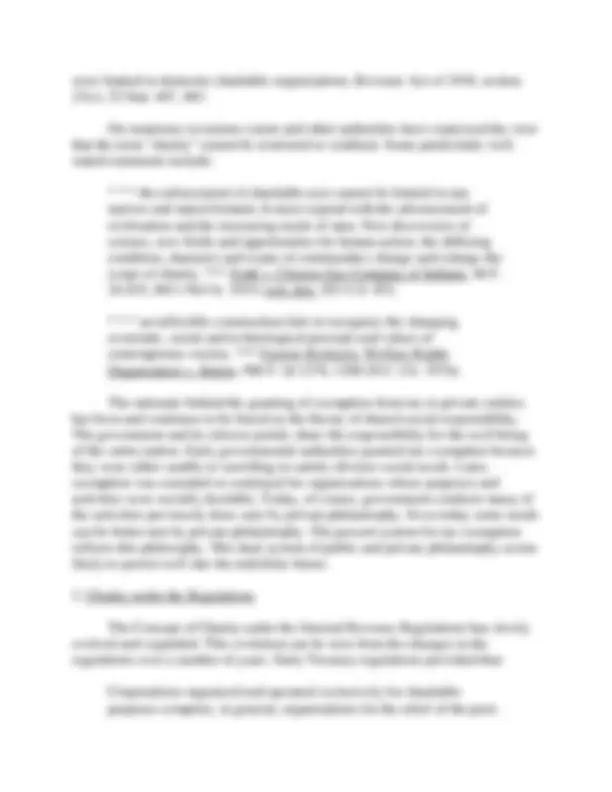
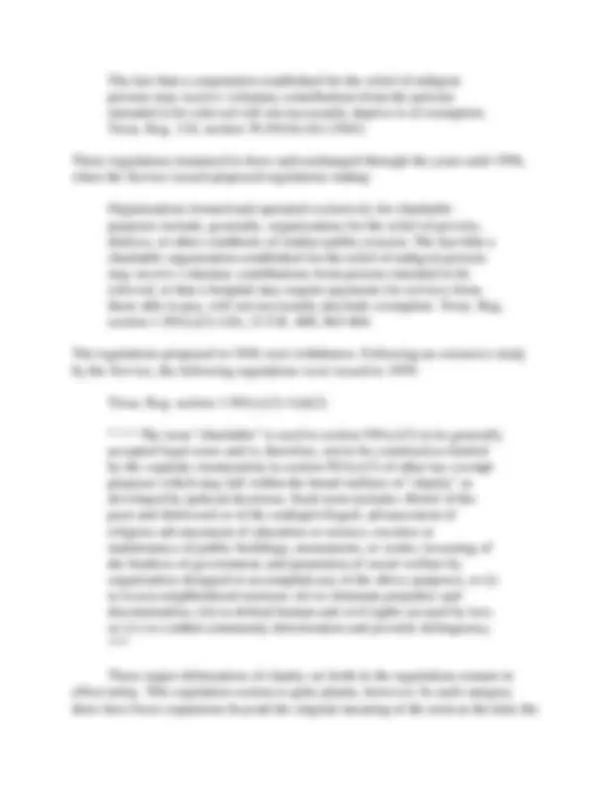
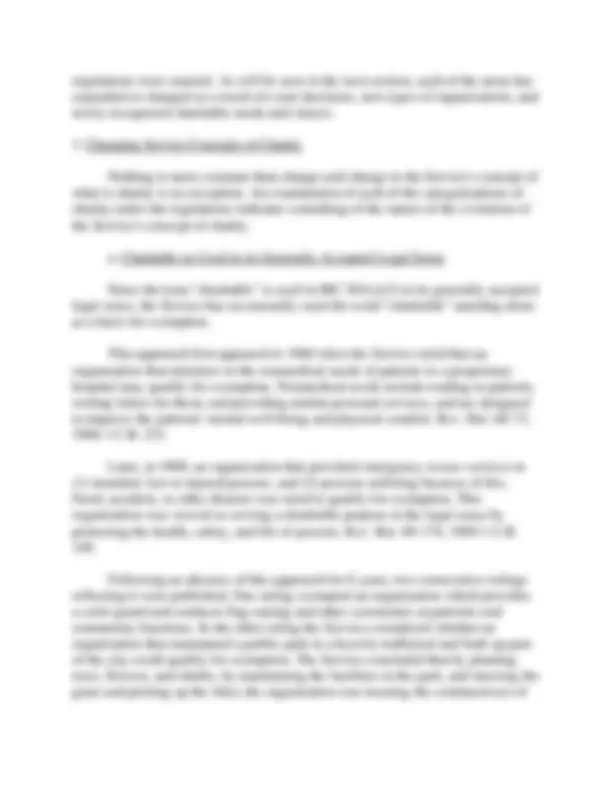

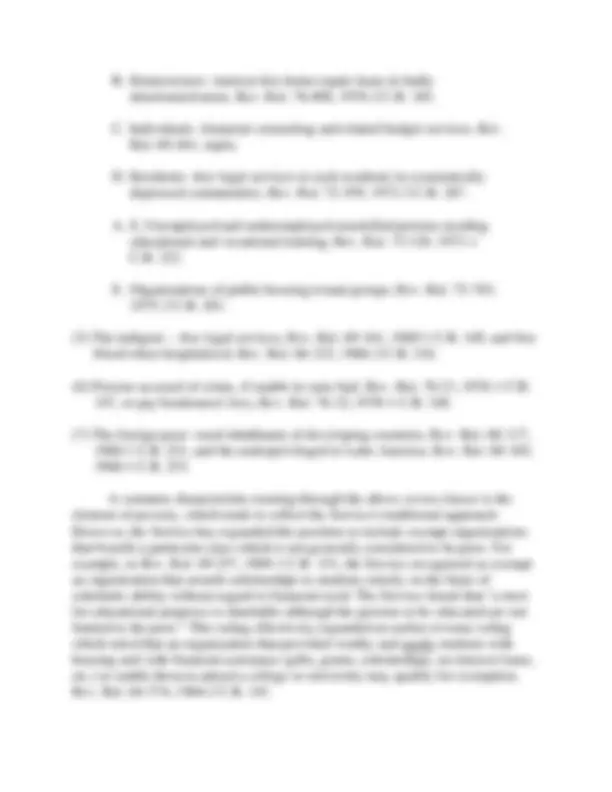
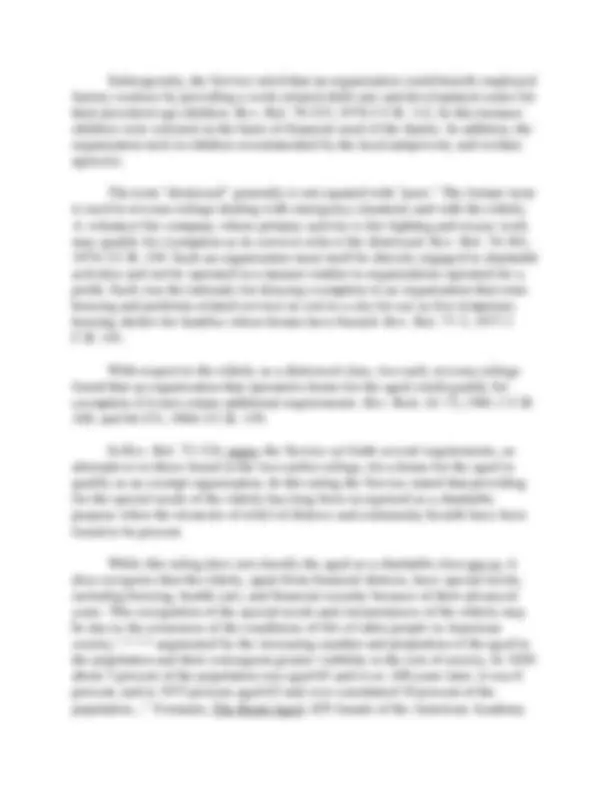
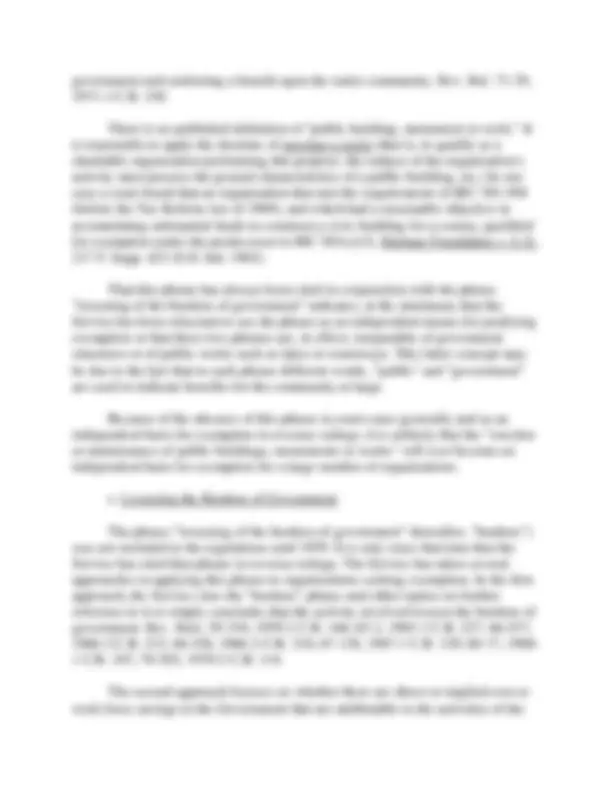
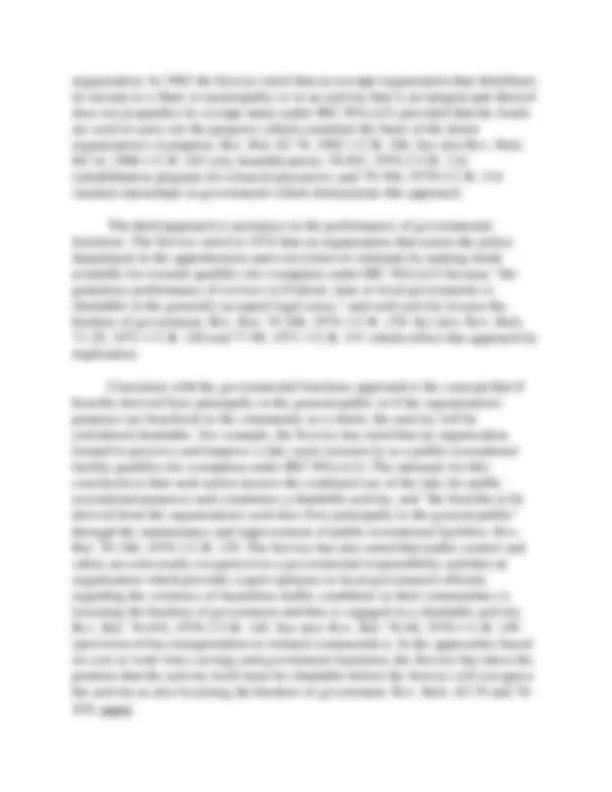
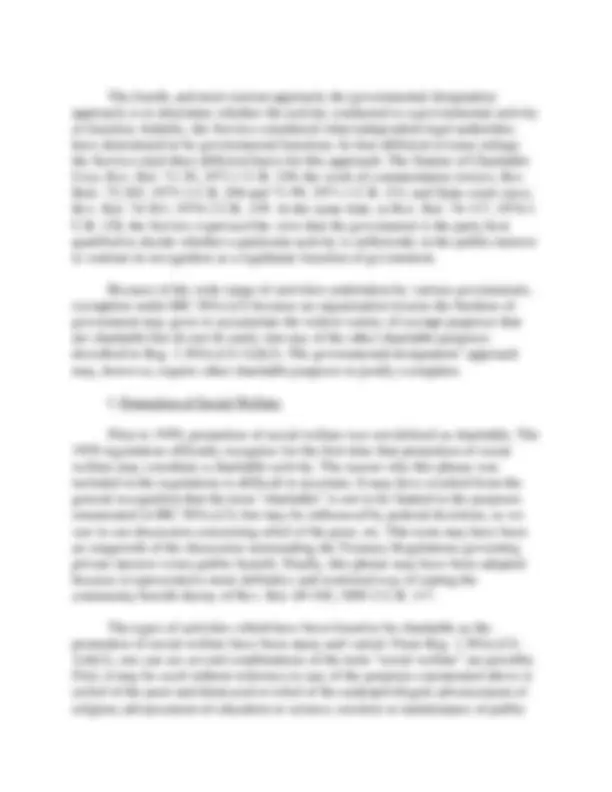
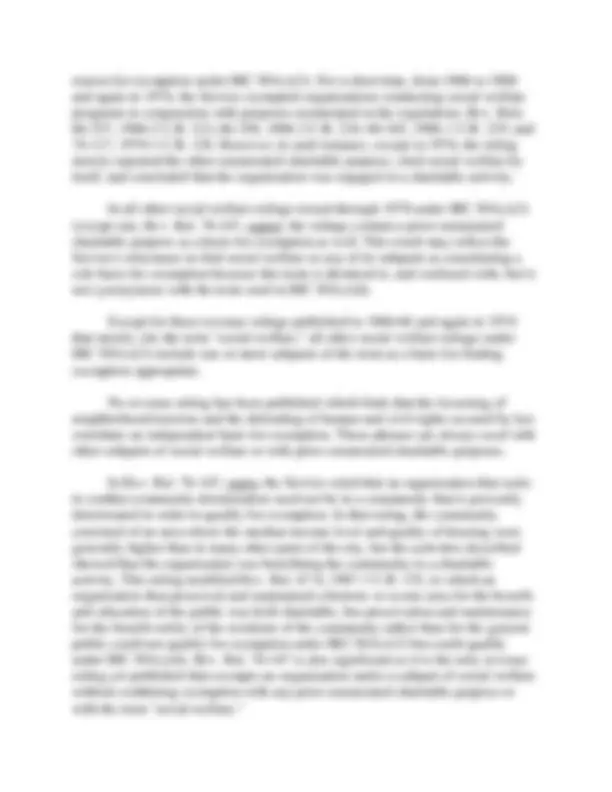
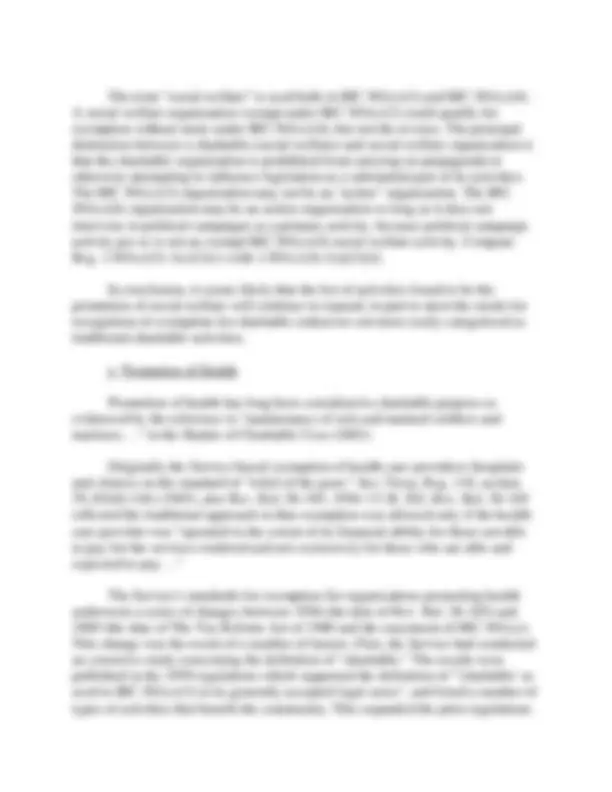
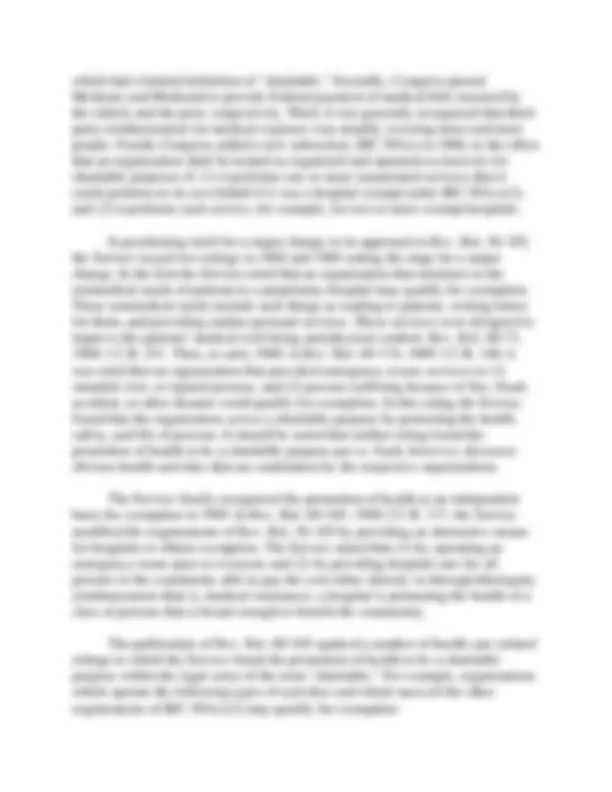

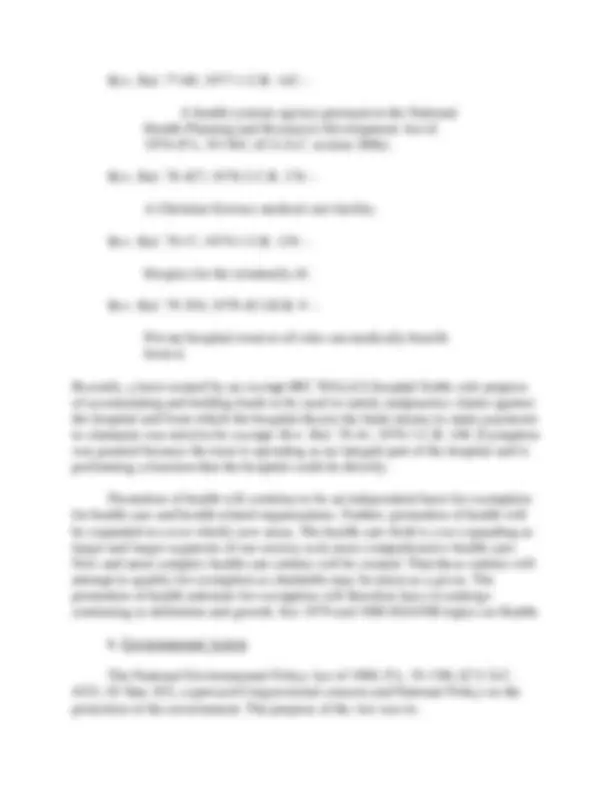
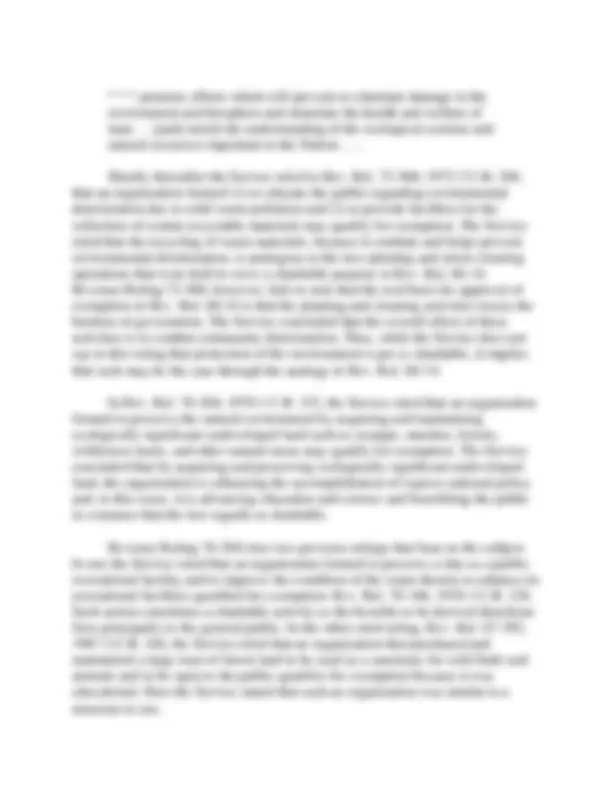
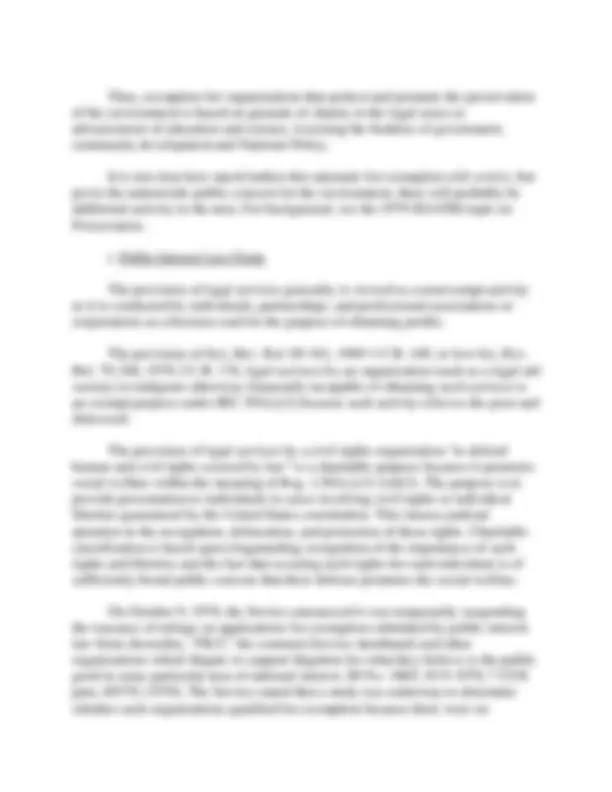
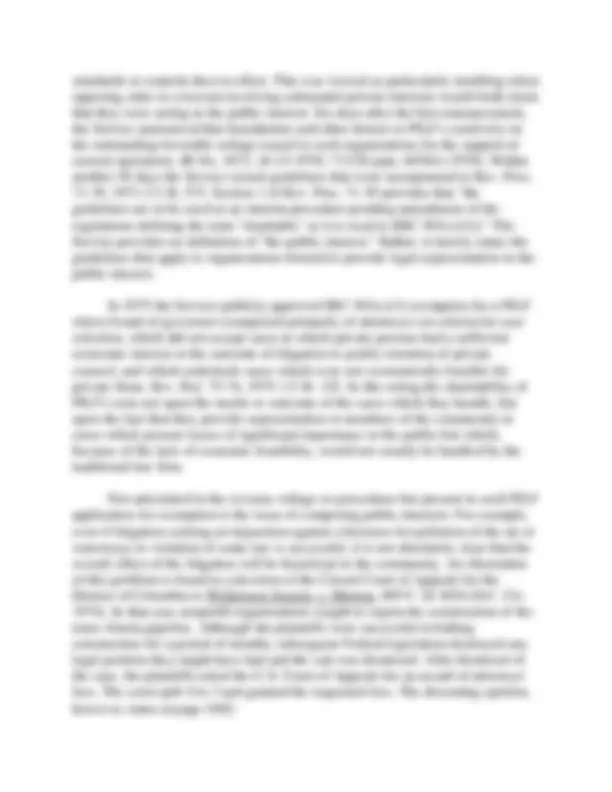

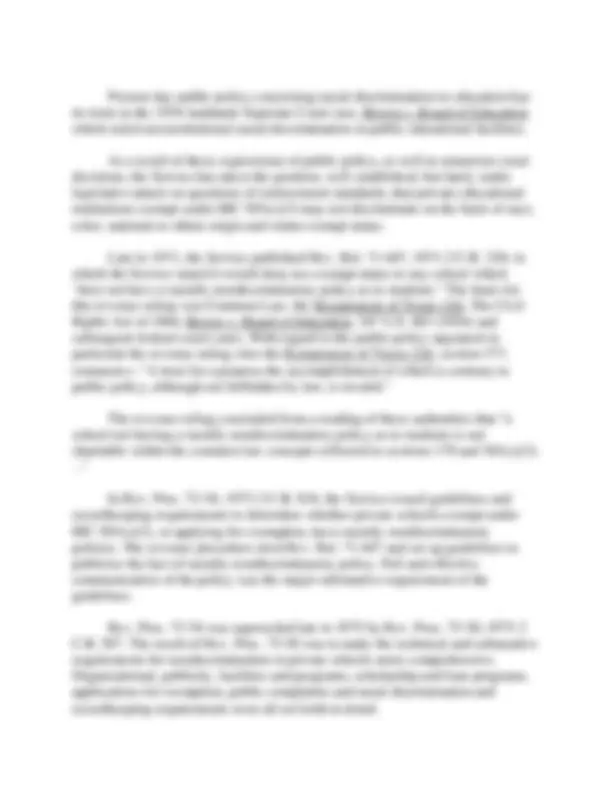
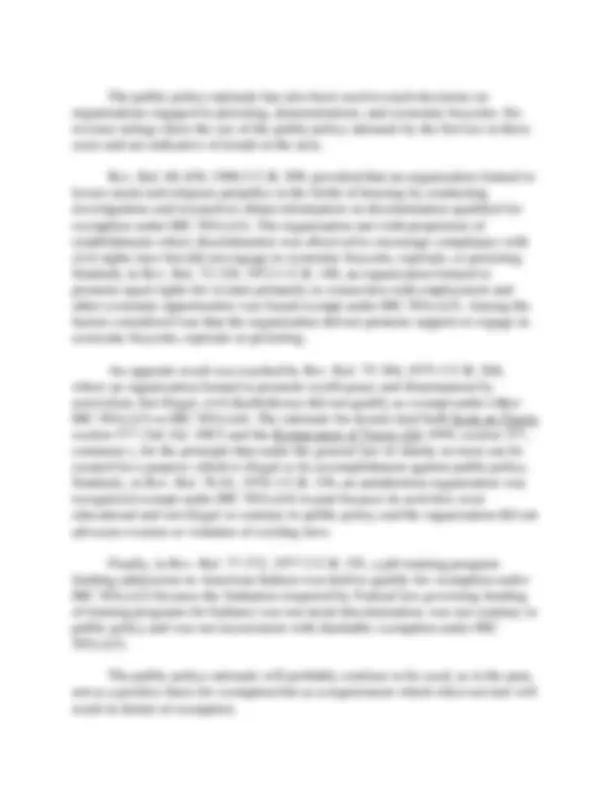
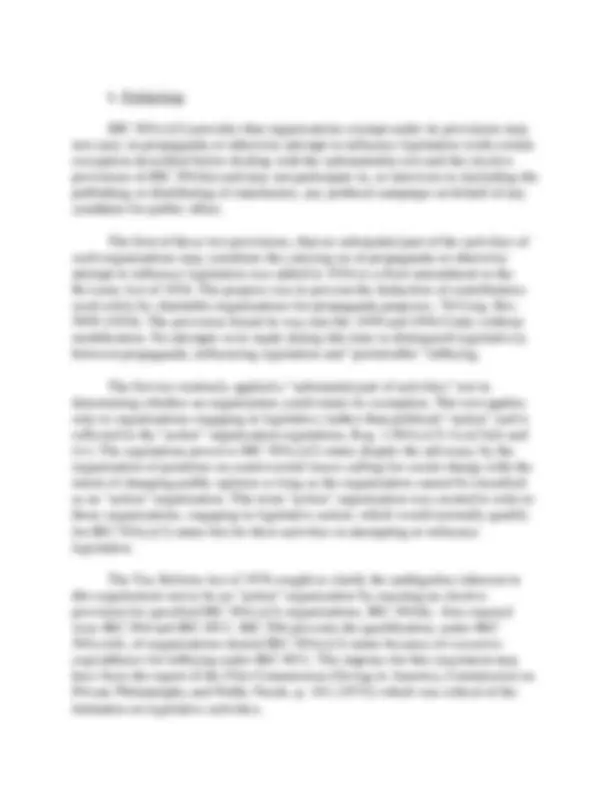
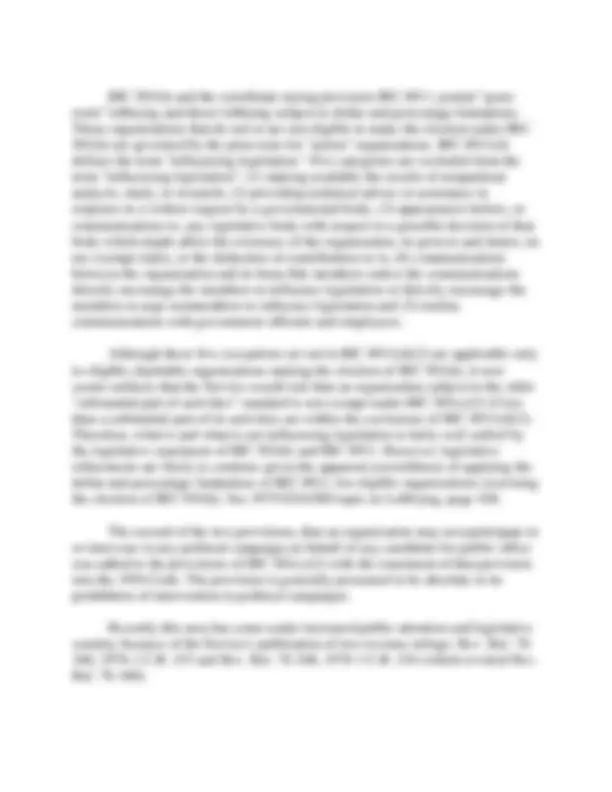
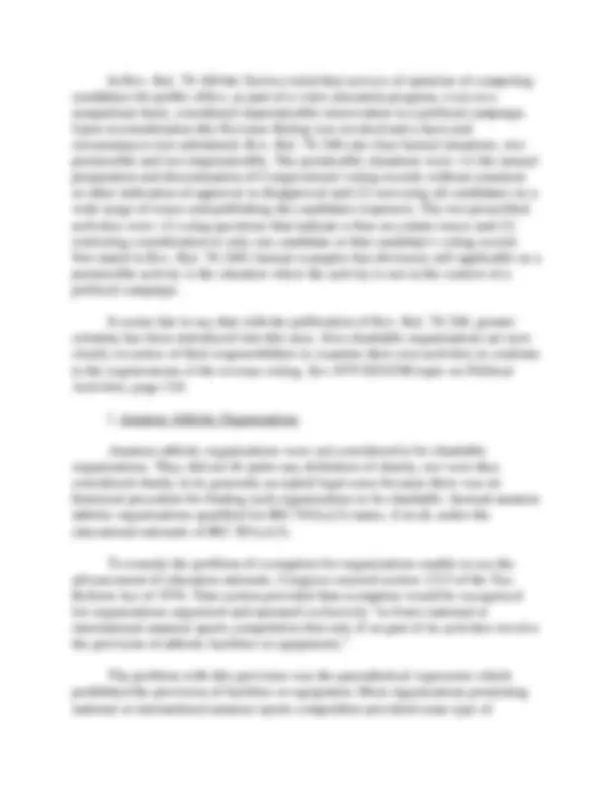

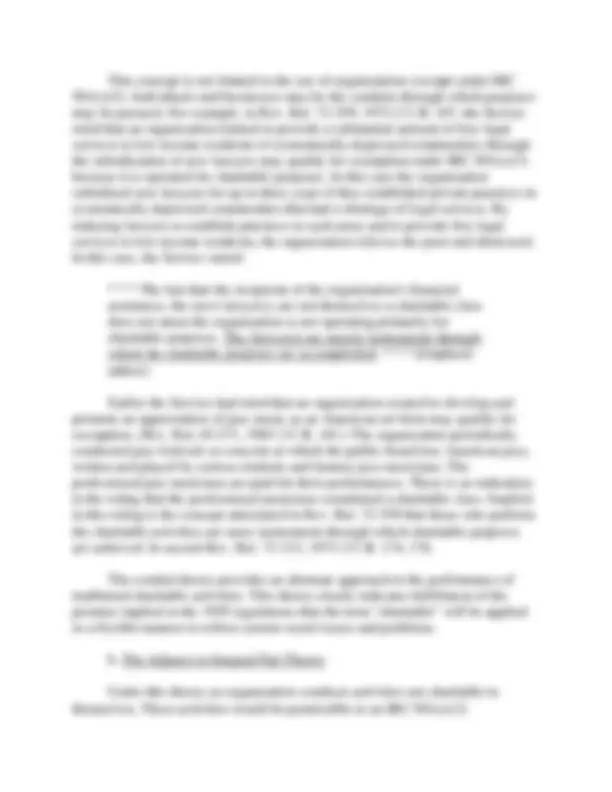
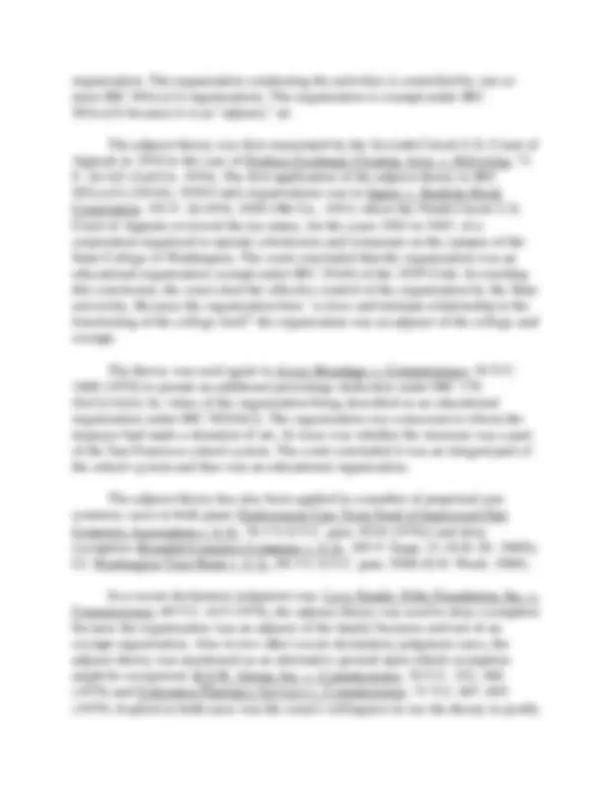
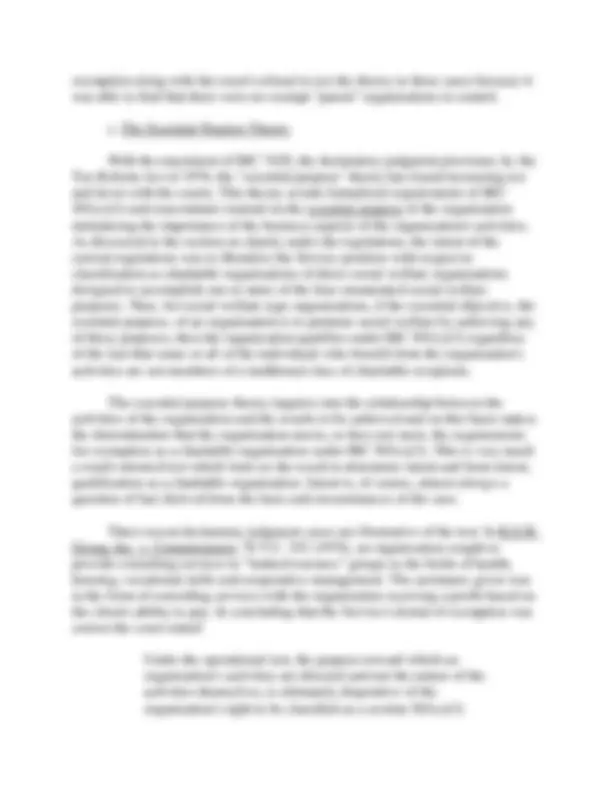




Study with the several resources on Docsity

Earn points by helping other students or get them with a premium plan


Prepare for your exams
Study with the several resources on Docsity

Earn points to download
Earn points by helping other students or get them with a premium plan
Community
Ask the community for help and clear up your study doubts
Discover the best universities in your country according to Docsity users
Free resources
Download our free guides on studying techniques, anxiety management strategies, and thesis advice from Docsity tutors
The guidelines for organizations to qualify for exemption under IRC 501(c)(3), including the definition of 'charitable' in its generally accepted legal sense, examples of exempt purposes, and restrictions on political activity. It also discusses the conduit theory and essential purpose theory in determining exemption.
Typology: Study notes
1 / 37

This page cannot be seen from the preview
Don't miss anything!






























The Internal Revenue Code section 501(c)(3) provides that an organization organized and operated for "charitable" purposes may qualify for exemption from federal income tax. The concept of what is charitable has varied, however, with the time, the place and the needs of a particular community. The concept of what is charitable is still evolving today. In this topic we will examine the historical sources of charitability, describe what has been and is charitable under the regulations, state the current Service concepts of charity as derived from revenue rulings and finally look at a variety of theories under which charity law continues to evolve.
Although the origins of the concept of charity go back to antiquity, the modern American legal concept of charity is derived principally from the Elizabethan Statute of Charitable Uses. The preamble of the Statute provides that some funds should be set aside for the following charities:
Statute of Charitable Uses, 1601, 43 Eliz. 1, C4.
Since the establishment of the first non-wartime federal income tax in the United States in 1894 exemption has been provided to charitable organizations. Although the Act of August 27, 1894, section 32; 28 Stat. 509 was held unconstitutional by the Supreme Court in Pollock v. Farmers' Loan & Trust Co., 158 U.S. 601 (1895), the language of the exemption was only slightly changed in the Corporation Excise Tax Act of 1909, which provided that the excise tax should not apply
Prior to the Act of 1894 the question of what to exempt did not arise except by virtue of statutory omission since in tax acts prior to that date the acts had specified the entities to be taxed. Three basic considerations underlay tax exemption, then and now:
Following approval of the sixteenth amendment (ratified February 3, 1913), which permitted the levy of a federal income tax on persons and effectively overruled the Supreme Court decision rendered in 1895 holding the federal income tax to be unconstitutional, the Tariff Act of 1913 was passed.
That Act includes the same exemption provision as the Corporation Excise Tax Act of 1909 cited earlier, except for the addition of the word "scientific" and the reordering in sequence of the exempt purposes. Act of October 3, 1913, Ch. 16, section IIG.(a), 38 Stat. 114, 172.
So far as the term "charitable" is concerned, there has been no extensive change through a series of revenue acts from the Tariff Act of 1913 to the present IRC 501(c)(3), although additional privileges, requirements, and categories have been added. For example, those organizations within what is now IRC 501(c)(3) were given the privilege, in addition to exemption, of allowance of a deduction for individual contributions by the Revenue Act of 1917, section 1201(2), 40 Stat. 300,
The fact that a corporation established for the relief of indigent persons may receive voluntary contributions from the persons intended to be relieved will not necessarily deprive it of exemption. Treas. Reg. 118, section 39.101(6)-(b) (1943).
These regulations remained in force and unchanged through the years until 1956, when the Service issued proposed regulations stating:
Organizations formed and operated exclusively for charitable purposes include, generally, organizations for the relief of poverty, distress, or other conditions of similar public concern. The fact that a charitable organization established for the relief of indigent persons may receive voluntary contributions from persons intended to be relieved, or that a hospital may require payments for services from those able to pay, will not necessarily preclude exemption. Treas. Reg. section 1.501(c)(3)-1(b), 21 F.R. 460, 463-464.
The regulations proposed in 1956 were withdrawn. Following an extensive study by the Service, the following regulations were issued in 1959:
Treas. Reg. section 1.501(c)(3)-1(d)(2)
These major delineations of charity set forth in the regulations remain in effect today. This regulation section is quite plastic, however. In each category there have been expansions beyond the original meaning of the term at the time the
regulations were enacted. As will be seen in the next section, each of the areas has expanded or changed as a result of court decisions, new types of organizations, and newly recognized charitable needs and classes.
Nothing is more constant than change and change in the Service's concept of what is charity is no exception. An examination of each of the categorizations of charity under the regulations indicates something of the nature of the evolution of the Service's concept of charity.
a. Charitable as Used in its Generally Accepted Legal Sense
Since the term "charitable" is used in IRC 501(c)(3) in its generally accepted legal sense, the Service has occasionally used the word "charitable" standing alone as a basis for exemption.
This approach first appeared in 1968 when the Service ruled that an organization that ministers to the nonmedical needs of patients in a proprietary hospital may qualify for exemption. Nonmedical needs include reading to patients, writing letters for them, and providing similar personal services, and are designed to improve the patients' mental well-being and physical comfort. Rev. Rul. 68-73, 1968-1 C.B. 251.
Later, in 1969, an organization that provided emergency rescue services to (1) stranded, lost or injured persons, and (2) persons suffering because of fire, flood, accident, or other disaster was ruled to qualify for exemption. This organization was viewed as serving a charitable purpose in the legal sense by protecting the health, safety, and life of persons. Rev. Rul. 69-174, 1969-1 C.B.
Following an absence of this approach for 8 years, two consecutive rulings reflecting it were published. One ruling exempted an organization which provides a color guard and conducts flag-raising and other ceremonies at patriotic and community functions. In the other ruling the Service considered whether an organization that maintained a public park in a heavily trafficked and built up part of the city could qualify for exemption. The Service concluded that by planting trees, flowers, and shrubs, by maintaining the facilities in the park, and mowing the grass and picking up the litter, the organization was insuring the continued use of
At least two revenue rulings adopted this approach. In Rev. Rul. 56-185, 1956-1 C.B. 202, the Service ruled that a hospital may qualify for exemption only if it was operated to the extent of its financial ability for those unable to pay for the Services rendered. In Rev. Rul. 57-467, 1957-2 C.B. 313 (later superseded), the Service ruled that an organization operating a home for aged people that does not accept charity guests and that requires the discharge of guests who fail to make certain required monthly payments is not organized and operated exclusively for charitable purposes and cannot therefore qualify for exemption under IRC 501(c)(3).
This position was in direct conflict with courts and commentators. While the decision in Markle failed to indicate the basis for the Service's approach, the court found the bequest to be for a charitable purpose. This decision also had the effect of stating that the promotion of health is a charitable purpose. In Estate of Carolyn E. Gray, supra, the court found that the Service's
The court then reviewed several previous court cases and concluded that
Another court found that
The Service has not singled out any particular class or group of persons as automatically being poor and distressed or as being underprivileged. It has found, however, since the publication of the current regulations, certain activities
conducted for, on behalf of, or to benefit identifiable classes of people may qualify as charitable activities. These classes and the related activities include:
(1) The elderly --
A. Homes for the aged, Rev. Ruls. 61-72, 1961-1 C.B. 188; 64-231, 1964-2 C.B. 139; and 72-124, 1972-1 C.B. 145.
B. Employment placement, Rev. Rul. 66-257, 1966-2 C.B. 212.
C. A senior citizens center, Rev. Rul. 75-198, 1975-1 C.B. 157.
D. A rural test home, Rev. Rul. 75-385, 1975-2 C.B. 205.
E. Meals for homebound, Rev. Rul. 76-244, 1976-1 C.B. 155.
F. Closed circuit radio broadcasting, Rev. Rul. 77-42, 1977-1 C.B.
G. Low cost transportation in unserved areas, Rev. Rul. 77-246, 1977-2 C.B. 190.
H. Specially constructed housing for the elderly, Rev. Rul. 79-18, 1979-1 C.B. 194.
(2) The needy-artists, musicians, composers, writers, and scholars otherwise financially unable to complete their projects, Rev. Rul. 66-103, 1966-1 C.B. 134, and women needing to market their cooking and needlework, Rev. Rul. 68-167, 1968-1 C.B. 255.
(3) The handicapped--meals for homebound, Rev. Rul. 76-244, supra, and low cost transportation in unserved areas, Rev. Rul. 77-246, supra. Specially constructed housing for the handicapped, Rev. Rul. 79-19, 1979-1 C.B. 195.
(4) Low income individuals --
A. Families--housing needs, Rev. Rul. 67-138, 1967-1 C.B. 129, and financial counseling and related budget services, Rev. Rul. 69- 441, 1969-1 C.B. 115.
Subsequently, the Service ruled that an organization could benefit employed factory workers by providing a work-related child care and development center for their preschool age children. Rev. Rul. 70-533, 1970-2 C.B. 112. In this instance children were selected on the basis of financial need of the family. In addition, the organization took in children recommended by the local antipoverty and welfare agencies.
The term "distressed" generally is not equated with "poor." The former term is used in revenue rulings dealing with emergency situations and with the elderly. A volunteer fire company whose primary activity is fire fighting and rescue work may qualify for exemption as its services relieve the distressed. Rev. Rul. 74-361, 1974-2 C.B. 159. Such an organization must itself be directly engaged in charitable activities and not be operated in a manner similar to organizations operated for a profit. Such was the rationale for denying exemption to an organization that rents housing and performs related services at cost to a city for use as free temporary housing shelter for families whose homes have burned. Rev. Rul. 77-3, 1977- C.B. 141.
With respect to the elderly as a distressed class, two early revenue rulings found that an organization that operated a home for the aged could qualify for exemption if it met certain additional requirements. Rev. Ruls. 61-72, 1961-1 C.B. 188, and 64-231, 1964-2 C.B. 139.
In Rev. Rul. 72-124, supra, the Service set forth several requirements, as alternatives to those found in the two earlier rulings, for a home for the aged to qualify as an exempt organization. In this ruling the Service stated that providing for the special needs of the elderly has long been recognized as a charitable purpose when the elements of relief of distress and community benefit have been found to be present.
While this ruling does not classify the aged as a charitable class per se, it does recognize that the elderly, apart from financial distress, have special needs, including housing, health care, and financial security because of their advanced years. This recognition of the special needs and circumstances of the elderly may be due to the awareness of the conditions of life of older people in American society," * * * augmented by the increasing number and proportion of the aged in the population and their consequent greater visibility to the rest of society. In 1850 about 3 percent of the population was aged 65 and over; 100 years later, it was 8 percent; and in 1975 persons aged 65 and over constituted 10 percent of the population..." Youmans, The Rural Aged, 429 Annals of the American Academy
of Politics and Social Science 81, 82 (January 1977). This awareness has been exemplified in the numerous revenue rulings governing activities benefitting the elderly.
No revenue ruling cites relief of the underprivileged by itself when describing whether or not a particular organization qualifies for exemption. Rather, the phrase "relief of the poor and distressed or relief of the underprivileged" is used entirely or merely the phrase "relief of the poor and distressed." In only one revenue ruling has the Service nearly described a particular class or group as definitely underprivileged. In that ruling, an organization had been formed in the United States to work directly with village groups, jungle colonies, and other groups in a Latin American country to assist underprivileged people in improving their living conditions through educational and self-help programs. Rev. Rul. 68- 165, 1968-1 C.B. 253. The organization's activities included furnishing tools, educational materials, and other supplies; it was primarily educational in nature. The Service concluded that furnishing tools and material to help improve living conditions of the underprivileged is charitable within the meaning of IRC 501(c)(3).
While the Service early recognized relief of the poor as a charitable purpose, at no time has it identified one or more classes or groups as automatically poor, distressed, or underprivileged so that any activity conducted for such a class by a nonprofit organization will enable the organization to secure exemption from Federal income tax. Rather, the Service has expanded that concept to include activities that benefit persons of low-income (monetary approach) and the elderly (sociological approach) on the basis of circumstances or special needs of the particular class. The Service does not use relief of the underprivileged as a separate reason for finding any organization exempt under IRC 501(c)(3).
c. Advancement of Religion, Education, or Science
IRC 501(c)(3) includes descriptive words in addition to the word "charitable." If the word "charitable" had been used alone, then the popular meaning of the word would have limited its applicability to only organizations which relieve the poor. However, Congress appears to have wanted to extend the concept of "charitable" to include other purposes and activities, as many States do, and not to limit the term merely to relief of the poor.
The terms "educational and scientific" are separately defined in their own regulations sections, 1.501(c)(3)-1(d)(3) and 1.501(c)(3)-1(d)(5) respectively. The
government and conferring a benefit upon the entire community. Rev. Rul. 71-29, 1971-1 C.B. 150.
There is no published definition of "public building, monument or work." It is reasonable to apply the doctrine of noscitur a sociis (that is, to qualify as a charitable organization performing this purpose, the subject of the organization's activity must possess the general characteristics of a public building, etc.) In one case a court found that an organization that met the requirements of IRC 501- (before the Tax Reform Act of 1969), and which had a reasonable objective in accumulating substantial funds to construct a civic building for a county, qualified for exemption under the predecessor to IRC 501(c)(3). Hulman Foundation v. U.S., 217 F. Supp. 423 (S.D. Ind. 1962).
That this phrase has always been cited in conjunction with the phrase "lessening of the burdens of government" indicates, at the minimum, that the Service has been reluctant to use the phrase as an independent means for justifying exemption or that these two phrases are, in effect, inseparable of government structures or of public works such as lakes or waterways. This latter concept may be due to the fact that in each phrase different words, "public" and "government" are used to indicate benefits for the community at large.
Because of the absence of this phrase in court cases generally and as an independent basis for exemption in revenue rulings, it is unlikely that the "erection or maintenance of public buildings, monuments or works" will ever become an independent basis for exemption for a large number of organizations.
e. Lessening the Burdens of Government
The phrase "lessening of the burdens of government" (hereafter, "burdens") was not included in the regulations until 1959. It is only since that time that the Service has cited that phrase in revenue rulings. The Service has taken several approaches in applying this phrase to organizations seeking exemption. In the first approach, the Service cites the "burdens" phrase and either makes no further reference to it or simply concludes that the activity involved lessens the burdens of government. Rev. Ruls. 59-310, 1959-2 C.B. 146; 65-2, 1965-1 C.B. 227; 66-257, 1966-2 C.B. 212; 66-358, 1966-2 C.B. 218; 67-138, 1967-1 C.B. 129; 68-17, 1968- 1 C.B. 247; 70-583, 1970-2 C.B. 114.
The second approach focuses on whether there are direct or implied cost or work force savings to the Government that are attributable to the activities of the
organization. In 1962 the Service ruled that an exempt organization that distributes its income to a State or municipality or to an activity that is an integral part thereof does not jeopardize its exempt status under IRC 501(c)(3) provided that the funds are used to carry out the purposes which constitute the basis of the donor organization's exemption. Rev. Rul. 62-78, 1962-1 C.B. 186. See also Rev. Ruls. 68-14, 1968-1 C.B. 243 (city beautification); 70-583, 1970-2 C.B. 114 (rehabilitation program for released prisoners); and 70-584, 1970-2 C.B. 114 (student internships in government) which demonstrate this approach.
The third approach is assistance in the performance of governmental functions. The Service ruled in 1974 that an organization that assists the police department in the apprehension and conviction of criminals by making funds available for rewards qualifies for exemption under IRC 501(c)(3) because "the gratuitous performance of services to Federal, state or local governments is charitable in the generally accepted legal sense," and such activity lessens the burdens of government. Rev. Rul. 74-246, 1974-1 C.B. 130. See also: Rev. Ruls. 71-29, 1971-1 C.B. 150 and 77-99, 1971-1 C.B. 151 which reflect this approach by implication.
Consistent with the governmental functions approach is the concept that if benefits derived flow principally to the general public or if the organization's purposes are beneficial to the community as a whole, the activity will be considered charitable. For example, the Service has ruled that an organization formed to preserve and improve a lake used extensively as a public recreational facility qualifies for exemption under IRC 501(c)(3). The rationale for this conclusion is that such action insures the continued use of the lake for public recreational purposes and constitutes a charitable activity, and "the benefits to be derived from the organization's activities flow principally to the general public" through the maintenance and improvement of public recreational facilities. Rev. Rul. 70-186, 1970-1 C.B. 129. The Service has also noted that traffic control and safety are universally recognized as a governmental responsibility and that an organization which provides expert opinions to local government officials regarding the existence of hazardous traffic conditions in their communities is lessening the burdens of government and thus is engaged in a charitable activity. Rev. Rul. 76-418, 1976-2 C.B. 145. See also: Rev. Rul. 78-68, 1978-1 C.B. 149 (provision of bus transportation in isolated communities). In the approaches based on cost or work force savings and government functions, the Service has taken the position that the activity itself must be charitable before the Service will recognize the activity as also lessening the burdens of government. Rev. Ruls. 62-78 and 76- 418, supra.
buildings, monuments, or works; or lessening of the burdens of government) or subparts listed below it (lessening neighborhood tension; elimination of prejudice and discrimination; promotion of human and civil rights; and combatting community deterioration and juvenile delinquency). Second, it may be used in conjunction with any of its subparts. The following list of revenue rulings indicates some of the various combinations used in finding an organization's activity charitable as promotion of social welfare:
(1) lessening neighborhood tensions
(2) eliminating prejudice and discrimination
(3) defense of human and civil rights secured by law
(4a) combatting community deterioration
(4b) combatting juvenile delinquency
Rev. Rul. 65-2, 1965-1 C.B. 227 (4b) (teaching a specific sport to children)
Rev. Rul. 67-138, 1967-1 C.B. 129 (4a) (providing assistance to low-income families to obtain improved housing)
Rev. Rul. 67-250, 1967-2 C.B. 182 (1, 2, 3, 4a, 4b) (education of public on need for housing available on a nondiscriminatory basis)
Rev. Rul. 67-391, 1967-2 C.B. 190 (4a) (development of community land use plan)
Rev. Rul. 68-14, 1968-1 C.B. 243 (4a) (assisting city tree planting and beautification projects)
Rev. Rul. 68-15, 1968-1 C.B. 244 (1, 2, 4a, 4b) (investigation and education of public on social problems)
Rev. Rul. 68-17, 1968-1 C.B. 247 (4a, 4b) (demonstration housing project for low-income families)
Rev. Rul. 68-70, 1968-1 C.B. 248 (2) (advancing equal job opportunities)
Rev. Rul. 68-438, 1968-2 C.B. 209 (1, 2, 3) (promoting lessing of racial and religious prejudice in the fields of housing and public accomodations)
Rev. Rul. 68-655, 1968-2 C.B. 213 (1, 2, 4a, 4b) (promoting racial integration in neighborhoods)
Rev. Rul. 70-79, 1970-1 C.B. 127 (4a) (conducting planning research for a metropolitan area)
Rev. Rul. 70-585, 1970-2 C.B. 115, Situation 2 (1, 2, 4a, 4b) (ameliorating housing needs of minorities by building new housing for low-income persons)
Rev. Rul. 72-228, 1972-1 C.B. 148 (2) (promotion of equal job rights for women)
Rev. Rul. 72-560, 1972-2 C.B. 248 (4a) (establishment of recycling center)
Rev. Rul. 74-587, 1974-2 C.B. 162 (1, 2, 4a, 4b) (stimulating economic development in high density urban areas by low-income minority and disadvantaged groups by providing financial assistance to business to obtain funds not available through normal commercial sources)
Rev. Rul. 76-147, 1976-1 C.B. 151 (4a) (preventing potential community deterioration)
Rev. Rul. 76-205, 1976-1 C.B. 154 (1) (establishment of immigrant aid center)
Rev. Rul. 76-419, 1976-2 C.B. 146 (4a, 4b) (purchasing blighted land in an economically depressed community)
With regard to the above listing several observations are in order. No revenue ruling published through 1977 cited promotion of social welfare alone as a
The term "social welfare" is used both in IRC 501(c)(3) and IRC 501(c)(4). A social welfare organization exempt under IRC 501(c)(3) could qualify for exemption without more under IRC 501(c)(4), but not the reverse. The principal distinction between a charitable (social welfare) and social welfare organization is that the charitable organization is prohibited from carrying on propaganda or otherwise attempting to influence legislation as a substantial part of its activities. The IRC 501(c)(3) organization may not be an "action" organization. The IRC 501(c)(4) organization may be an action organization so long as it does not intervene in political campaigns as a primary activity, because political campaign activity per se is not an exempt IRC 501(c)(4) social welfare activity. Compare Reg. 1.501(c)(3)-1(c)(3)(v) with 1.501(c)(4)-1(a)(2)(ii).
In conclusion, it seems likely that the list of activities found to be the promotion of social welfare will continue to expand, in part to meet the needs for recognition of exemption for charitable endeavors not more easily categorized as traditional charitable activities.
g. Promotion of Health
Promotion of health has long been considered a charitable purpose as evidenced by the reference to "maintenance of sick and maimed soldiers and mariners.. ." in the Statute of Charitable Uses (1601).
Originally the Service based exemption of health care providers (hospitals and clinics) on the standard of "relief of the poor." See: Treas. Reg. 118, section 39.101(6)-1(b) (1943), also Rev. Rul. 56-185, 1956-1 C.B. 202. Rev. Rul. 56- reflected the traditional approach in that exemption was allowed only if the health care provider was "operated to the extent of its financial ability for those not able to pay for the services rendered and not exclusively for those who are able and expected to pay.. ."
The Service's standards for exemption for organizations promoting health underwent a series of changes between 1956 (the date of Rev. Rul. 56-185) and 1969 (the date of The Tax Reform Act of 1969 and the enactment of IRC 501(e)). This change was the result of a number of factors. First, the Service had conducted an extensive study concerning the definition of "charitable." The results were published in the 1959 regulations which supported the definition of "'charitable' as used in IRC 501(c)(3) in its generally accepted legal sense", and listed a number of types of activities that benefit the community. This expanded the prior regulations
which had a limited definition of "charitable." Secondly, Congress passed Medicare and Medicaid to provide Federal payment of medical bills incurred by the elderly and the poor, respectively. Third, it was generally recognized that third- party reimbursement for medical expenses was steadily covering more and more people. Fourth, Congress added a new subsection, IRC 501(e) in 1968, to the effect that an organization shall be treated as organized and operated exclusively for charitable purposes if: (1) it performs one or more enumerated services that it could perform on its own behalf if it was a hospital exempt under IRC 501(c)(3), and (2) it performs such service, for example, for two or more exempt hospitals.
In positioning itself for a major change to its approach in Rev. Rul. 56-185, the Service issued two rulings in 1968 and 1969 setting the stage for a major change. In the first the Service ruled that an organization that ministers to the nonmedical needs of patients in a proprietary hospital may qualify for exemption. These nonmedical needs include such things as reading to patients, writing letters for them, and providing similar personal services. These services were designed to improve the patients' medical well-being and physical comfort. Rev. Rul. 68-73, 1968-1 C.B. 251. Then, in early 1969, in Rev. Rul. 69-174, 1969-1 C.B. 149, it was ruled that an organization that provided emergency rescue services to (1) stranded, lost, or injured persons, and (2) persons suffering because of fire, flood, accident, or other disaster could qualify for exemption. In this ruling the Service found that the organization serves a charitable purpose by protecting the health, safety, and life of persons. It should be noted that neither ruling found the promotion of health to be a charitable purpose per se. Each, however, discusses obvious health activities that are undertaken by the respective organizations.
The Service finally recognized the promotion of health as an independent basis for exemption in 1969. In Rev. Rul. 69-545, 1969-2 C.B. 117, the Service modified the requirements of Rev. Rul. 56-185 by providing an alternative means for hospitals to obtain exemption. The Service stated that (1) by operating an emergency room open to everyone and (2) by providing hospital care for all persons in the community able to pay the cost either directly or through third-party reimbursement (that is, medical insurance), a hospital is promoting the health of a class of persons that is broad enough to benefit the community.
The publication of Rev. Rul. 69-545 sparked a number of health care related rulings in which the Service found the promotion of health to be a charitable purpose within the legal sense of the term "charitable." For example, organizations which operate the following types of activities and which meet all the other requirements of IRC 501(c)(3) may qualify for exemption: